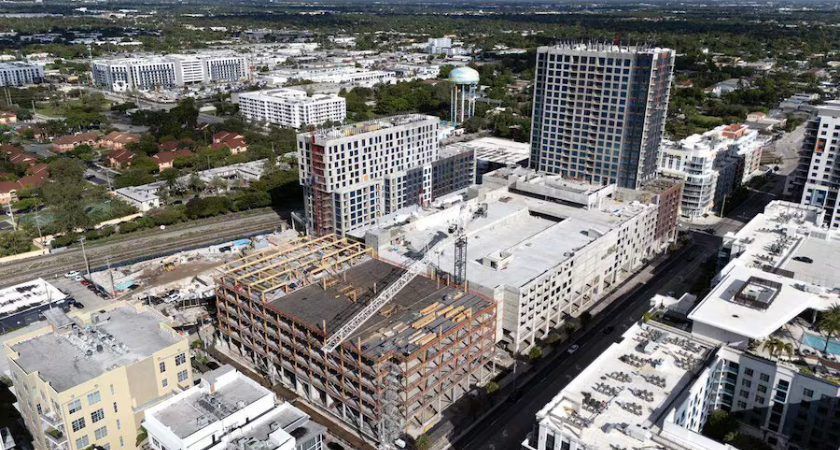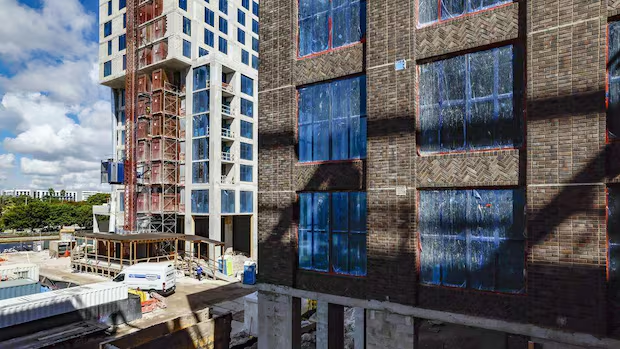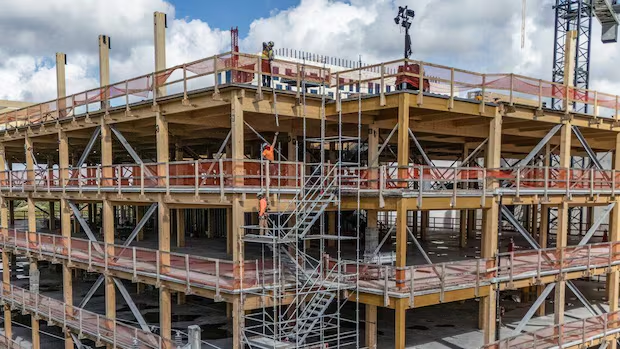
FORT LAUDERDALE — Downtown Fort Lauderdale is in the middle of a real estate and cultural boom, and at its heart is the highly anticipated $500 million redevelopment of FAT Village (Flagler, Art, Technology). What began as a quirky arts hub with warehouses, coffee shops, and monthly art walks is being reimagined into a large-scale mixed-use district combining housing, retail, art, and office space.

The redevelopment, led by global real estate investment group Hines in partnership with Urban Street Development, has already made significant progress. On the 5.6-acre site along North Andrews Avenue, three towers — two residential buildings and one office building — have topped off, with a fourth structure planned.
“It’s not just a single place to go to work or a single place to live, but a place to live, shop, work, be, hang out,” said Alan Kennedy, managing director at Hines. “If we only deliver a one-use project, then we failed.”
The project is scheduled to open its retail and residential components by 2027, bringing with it nearly 600 rental units, ground-floor shops, restaurants, art installations, and office space.
Founded in 2000 by Doug McCraw and Lutz Hofbauer, FAT Village originally functioned as a nonprofit arts district filled with figure-drawing classes, local galleries, and independent businesses. When Hines purchased the land, they intentionally partnered with McCraw, Hofbauer, and Urban Street Development’s Alan Hooper and Tim Petrillo, to ensure the new district kept its artistic DNA intact.
“Instead of just buying the land and saying, ‘see ya,’ we took all four of those guys and made them our equal partners in the development of FAT Village,” Kennedy said. “We felt that the engagement of the local folks, especially the art community leaders, were essential to having a successful project.”
Though some beloved businesses like Maguire’s Hill 16 closed, Kennedy emphasized that no residents were displaced by the construction.
The redevelopment includes a 24-story luxury residential tower with 355 units and a 13-story building with 246 workforce housing units, designed to make downtown living accessible to a wider income range.

“We’re trying to make it so that somebody who doesn’t make $150,000 a year, like what you see in the rest of Flagler Village, can have a place to live here,” Kennedy said. “It’s very similar to the tall one. It’s kind of like the punk kid sister. It’s smaller, but it’s a little edgier.”
Amenities include a dog park, modern two-bedroom apartments, and proximity to transit, including the Brightline station just blocks away.
The standout feature of the redevelopment is T3, a six-story, 180,000-square-foot office building made largely of mass timber. Named for “Timber, Transit, and Technology,” the building is designed to highlight sustainability with renewable pine and spruce materials harvested from managed forests.
Kennedy explained that the exposed wood interiors, large windows, private balconies, and natural lighting aim to create a healthier, eco-conscious office environment.
“It’s a very important thing, making guests of the building feel more comfortable,” Kennedy said.
The building also includes a fitness center, bike storage, co-working spaces, and a conference center, with several companies already negotiating leases.
Local leaders say FAT Village will be transformative for the city.
“It just further demonstrates that there’s a growing critical mass in Flagler Village with FAT Village coming,” said Jenni Morejon, president and CEO of Fort Lauderdale’s Downtown Development Authority. “There’s an employee population, a resident population that will support retail.”
Real estate brokers agree. Christina Jolley, senior vice president at Blanca Commercial Real Estate, noted that companies in tech, healthcare, law, and marketing are eyeing FAT Village.
“The fact that we now have office there really signals to the market that Fort Lauderdale has matured,” Jolley said.
Developers envision FAT Village as more than just luxury living or commercial space. They are working with artists to design murals, sculptures, and community-focused public spaces, blending the neighborhood’s artistic heritage with its new identity.
“The whole idea is that the street is activated and friendly and engaging and brings people in, because that’s where communities come together, right?” Kennedy said. “We are not trying to make it so that it’s a fortress. We’re trying to make it so that FAT Village bleeds out to the community.”
With its combination of housing, art, retail, and green building practices, FAT Village is poised to redefine what downtown Fort Lauderdale looks like — a place where commerce, culture, and community intersect.
Originally reported by Amanda Rosa in Tampa Bay Times.